Comparison of Optical Properties and Fracture Loads of Multilayer Monolithic Zirconia Crowns with Different Yttria Levels
Abstract
:1. Introduction
2. Materials and Methods
2.1. Sample Preparation
2.2. Optical Property Analyses
2.3. Fracture Load Testing
2.4. Statistical Analysis
3. Results
3.1. Color Accuracy and Translucency
3.2. Fracture Loads
4. Discussion
5. Conclusions
- An increased yttria level was associated with enhanced translucency. The multilayer monolithic zirconia crown containing a 4Y + 5Y (AZ) exhibited superior color accuracy compared to that containing only 3Y (SZ), which showed notable color deviations.
- Variations in the fracture loads were primarily attributed to differences in the tooth position or thickness. Although AZ demonstrated lower fracture loads than SZ, it still showed sufficient values (>1260 N) to withstand biting or occlusion forces.
- When selecting multilayer monolithic zirconia with higher or combined yttria levels, ensuring a minimum thickness of 1.0 mm is necessary to meet both aesthetic and functional requirements in dental applications.
Author Contributions
Funding
Data Availability Statement
Acknowledgments
Conflicts of Interest
References
- Alghazzawi, T.F. Advancements in CAD/CAM technology: Options for practical implementation. J. Prosthodont. Res. 2016, 60, 72–84. [Google Scholar] [CrossRef]
- Camposilvan, E.; Leone, R.; Gremillard, L.; Sorrentino, R.; Zarone, F.; Ferrari, M.; Chevalier, J. Aging resistance, mechanical properties and translucency of different yttria-stabilized zirconia ceramics for monolithic dental crown applications. Dent. Mater. 2018, 34, 879–890. [Google Scholar] [CrossRef]
- Kolakarnprasert, N.; Kaizer, M.R.; Kim, D.K.; Zhang, Y. New multi-layered zirconias: Composition, microstructure and translucency. Dent. Mater. 2019, 35, 797–806. [Google Scholar] [CrossRef]
- Huang, B.; Chen, M.; Wang, J.; Zhang, X. Advances in zirconia-based dental materials: Properties, classification, applications, and future prospects. J. Dent. 2024, 147, 105111. [Google Scholar] [CrossRef]
- Nakamura, K.; Harada, A.; Inagaki, R.; Kanno, T.; Niwano, Y.; Milleding, P.; Örtengren, U. Fracture resistance of monolithic zirconia molar crowns with reduced thickness. Acta Odontol. Scand. 2015, 73, 602–608. [Google Scholar] [CrossRef] [PubMed]
- Leitão, C.I.M.B.; Fernandes, G.V.d.O.; Azevedo, L.P.P.; Araújo, F.M.; Donato, H.; Correia, A.R.M. Clinical performance of monolithic CAD/CAM tooth-supported zirconia restorations: Systematic review and meta-analysis. J. Prosthodont. Res. 2022, 66, 374–384. [Google Scholar] [CrossRef]
- Kang, C.-M.; Peng, T.-Y.; Shimoe, S. Color accuracy of different types of monolithic multilayer precolored zirconia ceramics. J. Prosthet. Dent. 2020, 124, 789.e1–789.e7. [Google Scholar] [CrossRef] [PubMed]
- Li, X.; Wang, Q.; Qiu, X.; Zhao, B. Effect of different CAD/CAM cutting depths on the post-fatigue load-bearing capacity of novel multilayer zirconia restorations. J. Dent. 2021, 111, 103709. [Google Scholar] [CrossRef] [PubMed]
- Rosentritt, M.; Preis, V.; Schmid, A.; Strasser, T. Multilayer zirconia: Influence of positioning within blank and sintering conditions on the in vitro performance of 3-unit fixed partial dentures. J. Prosthet. Dent. 2022, 127, 141–145. [Google Scholar] [CrossRef]
- Kaizer, M.R.; Kolakarnprasert, N.; Rodrigues, C.; Chai, H.; Zhang, Y. Probing the interfacial strength of novel multi-layer zirconias. Dent. Mater. 2020, 36, 60–67. [Google Scholar] [CrossRef] [PubMed]
- Ziyad, T.A.; Abu-Naba’a, L.A.; Almohammed, S.N. Optical properties of CAD-CAM monolithic systems compared: Three multi-layered zirconia and one lithium disilicate system. Heliyon 2021, 7, e08151. [Google Scholar] [CrossRef]
- Rinke, S.; Metzger, A.; Ziebolz, H. Multilayer super-translucent zirconia for chairside fabrication of a monolithic posterior crown. Case Rep. Dent. 2022, 2022, 4474227. [Google Scholar] [CrossRef]
- Tabatabaian, F.; Motamedi, E.; Sahabi, M.; Torabzadeh, H.; Namdari, M. Effect of thickness of monolithic zirconia ceramic on final color. J. Prosthet. Dent. 2018, 120, 257–262. [Google Scholar] [CrossRef]
- Kang, C.-M.; Peng, T.-Y.; Huang, H.-H. Effects of thickness of different types of high-translucency monolithic multilayer precolored zirconia on color accuracy: An in vitro study. J. Prosthet. Dent. 2021, 126, 587.e1–587.e8. [Google Scholar] [CrossRef] [PubMed]
- Lameira, D.P.; Silva, W.; Silva, F.A.E.; De Souza, G.M. Fracture Strength of Aged Monolithic and Bilayer Zirconia-Based Crowns. BioMed Res. Int. 2015, 2015, 418641. [Google Scholar] [CrossRef] [PubMed]
- Kim, S.H.; Yeo, M.Y.; Choi, S.Y.; Park, E.J. Fracture Resistance of Monolithic Zirconia Crowns Depending on Different Marginal Thicknesses. Materials 2022, 15, 4861. [Google Scholar] [CrossRef]
- Kang, C.-M.; Hsu, W.-C.; Chen, M.-S.; Wu, H.-Y.; Mine, Y.; Peng, T.-Y. Fracture characteristics and translucency of multilayer monolithic zirconia crowns of various thicknesses. J. Dent. 2024, 145, 105023. [Google Scholar] [CrossRef] [PubMed]
- Kim, H.-K.; Yoo, K.-W.; Kim, S.-J.; Jung, C.-H. Phase transformations and subsurface changes in three dental zirconia grades after sandblasting with various Al2O3 particle sizes. Materials 2021, 14, 5321. [Google Scholar] [CrossRef] [PubMed]
- Alraheam, I.A.; Donovan, T.; Boushell, L.; Cook, R.; Ritter, A.V.; Sulaiman, T.A. Fracture load of two thicknesses of different zirconia types after fatiguing and thermocycling. J. Prosthet. Dent. 2020, 123, 635–640. [Google Scholar] [CrossRef] [PubMed]
- Heffernan, M.J.; Aquilino, S.; Diaz-Arnold, A.M.; Haselton, D.; Stanford, C.M.; Vargas, M. Relative Translucency of Six All-Ceramic Systems. Part II: Core and Veneer Materials. J. Prosthet. Dent. 2002, 88, 10–15. [Google Scholar] [CrossRef]
- Reich, S. Tooth-colored CAD/CAM monolithic restorations. Int. J. Comput. Dent. 2015, 18, 131–146. [Google Scholar] [PubMed]
- Ritter, J.E. Predicting lifetimes of materials and material structures. Dent. Mater. 1995, 11, 142–146. [Google Scholar] [CrossRef] [PubMed]
- Heydecke, G.; Butz, F.; Binder, J.R.; Strub, J.R. Material characteristics of a novel shrinkage-free ZrSiO4 ceramic for the fabrication of posterior crowns. Dent. Mater. 2007, 23, 785–791. [Google Scholar] [CrossRef] [PubMed]
- Pöppel, M.L.; Rosentritt, M.; Sturm, R.; Beuer, F.; Hey, J.; Schmid, A.; Schmidt, F. Fracture load and patterns of monolithic three-unit anterior fixed dental prostheses after in vitro artificial aging—A comparison between color-gradient and strength-gradient multilayer zirconia materials with varying yttria content. J. Clin. Med. 2022, 11, 4982. [Google Scholar] [CrossRef]
- Badr, Z.; Culp, L.; Duqum, I.; Lim, C.H.; Zhang, Y.; Sulaiman, T.A. Survivability and fracture resistance of monolithic and multi-yttria-layered zirconia crowns as a function of yttria content: A mastication simulation study. J. Esthet. Restor. Dent. 2022, 34, 633–640. [Google Scholar] [CrossRef] [PubMed]
- Indergård, J.A.; Skjold, A.; Schriwer, C.; Øilo, M. Effect of cementation techniques on fracture load of monolithic zirconia crowns. Biomater. Investig. Dent. 2021, 8, 160–169. [Google Scholar] [CrossRef]
- Patil, S.R.; Maragathavalli, G.; Ramesh, D.N.S.V.; Agrawal, R.; Khandelwal, S.; Hattori, T.; Suzuki, K.; Nagasawa, M.; Sugita, Y.; Maeda, H.; et al. Aassessment of maximum bite force in pre-treatment and post treatment patients of oral submucous fibrosis: A prospective clinical study. J. Hard Tissue Biol. 2021, 30, 211–216. [Google Scholar] [CrossRef]
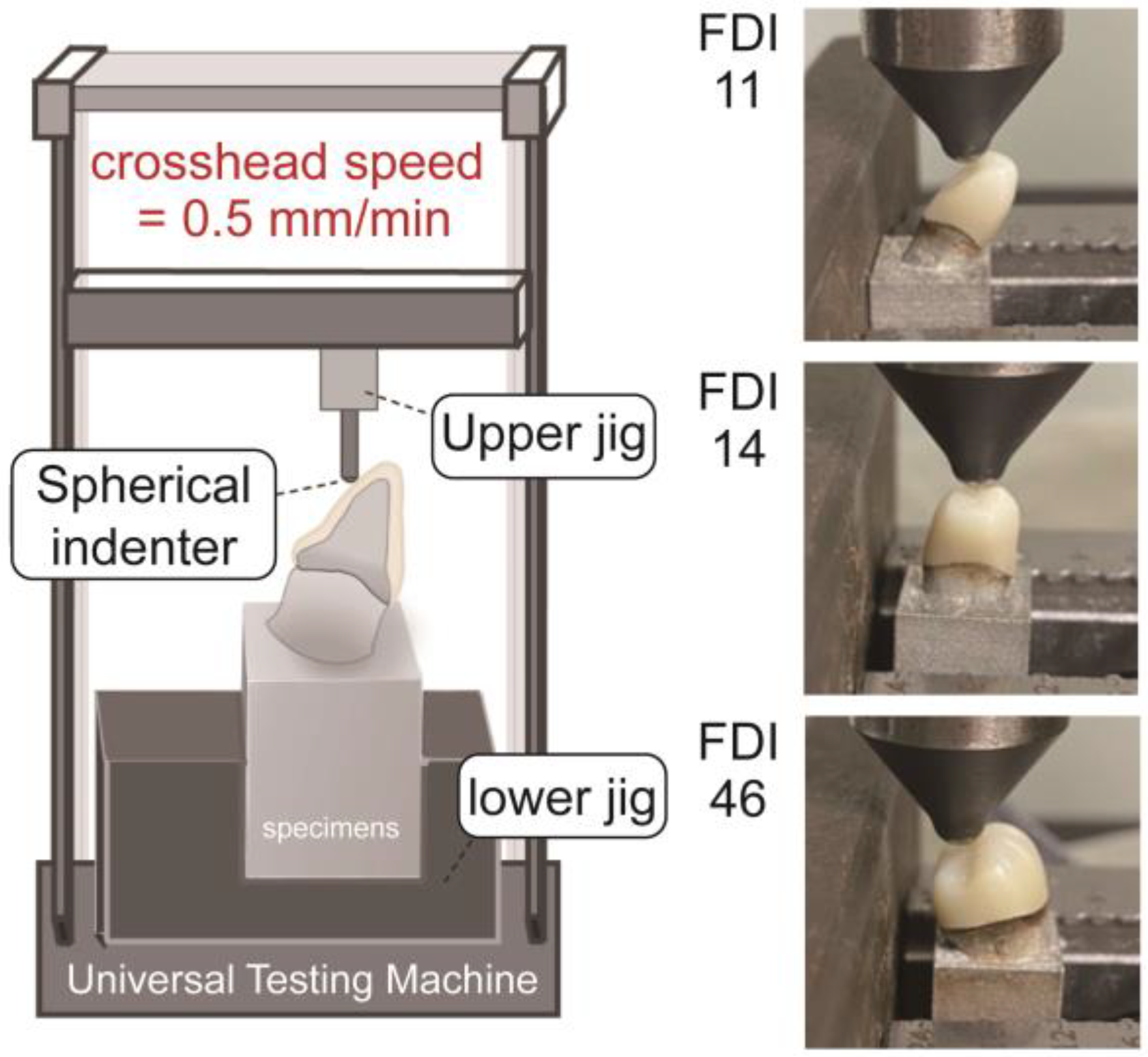
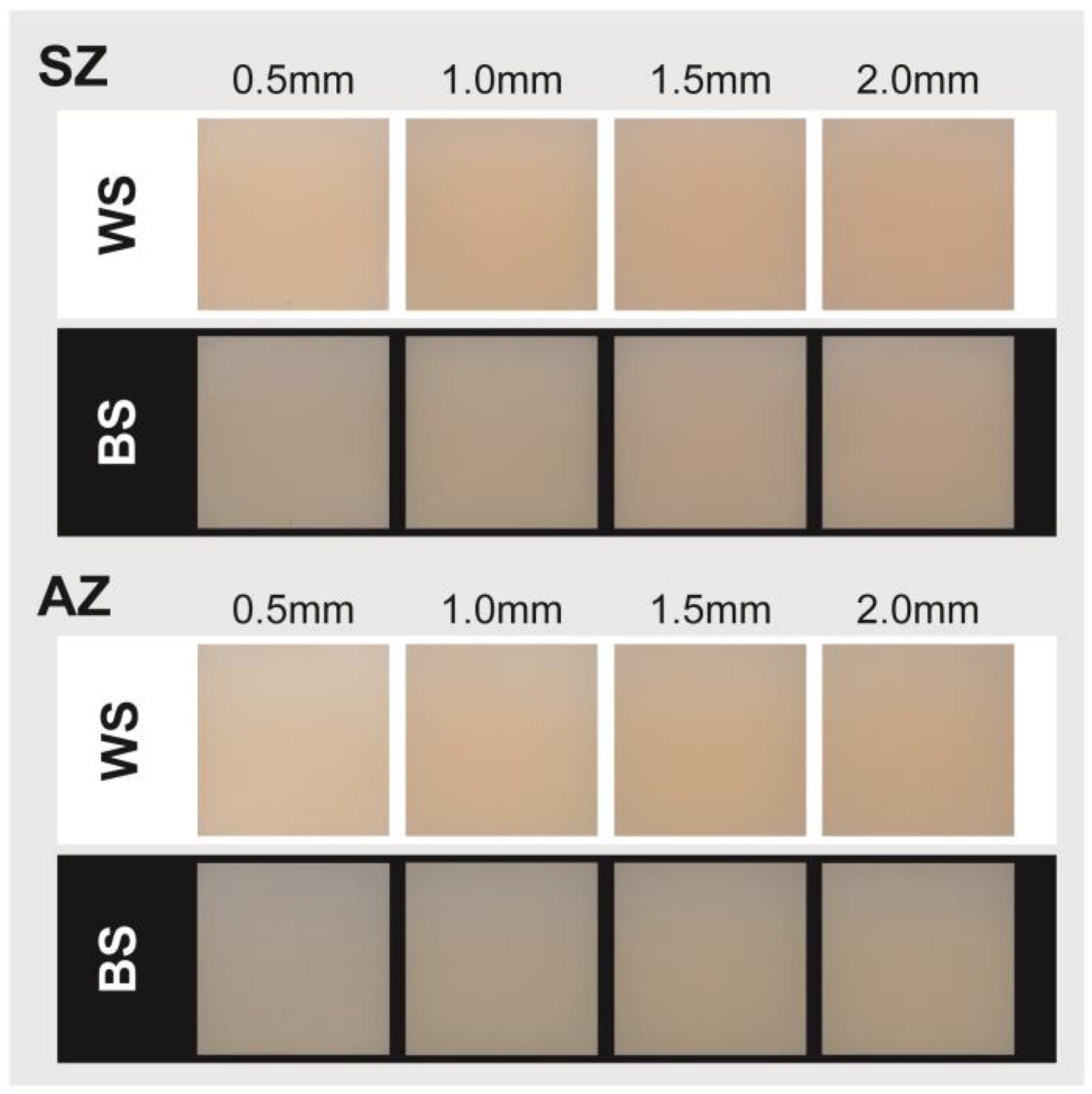
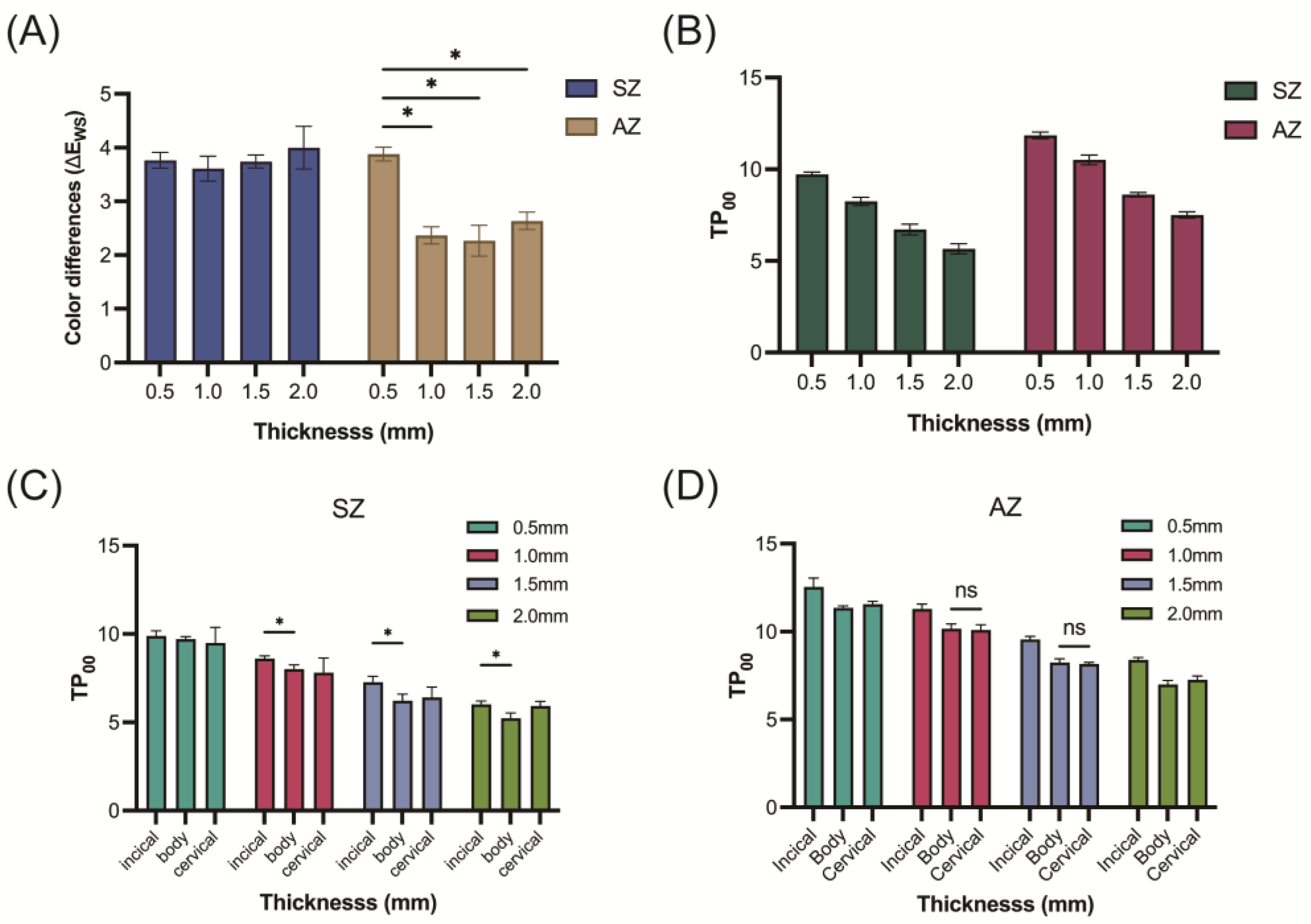
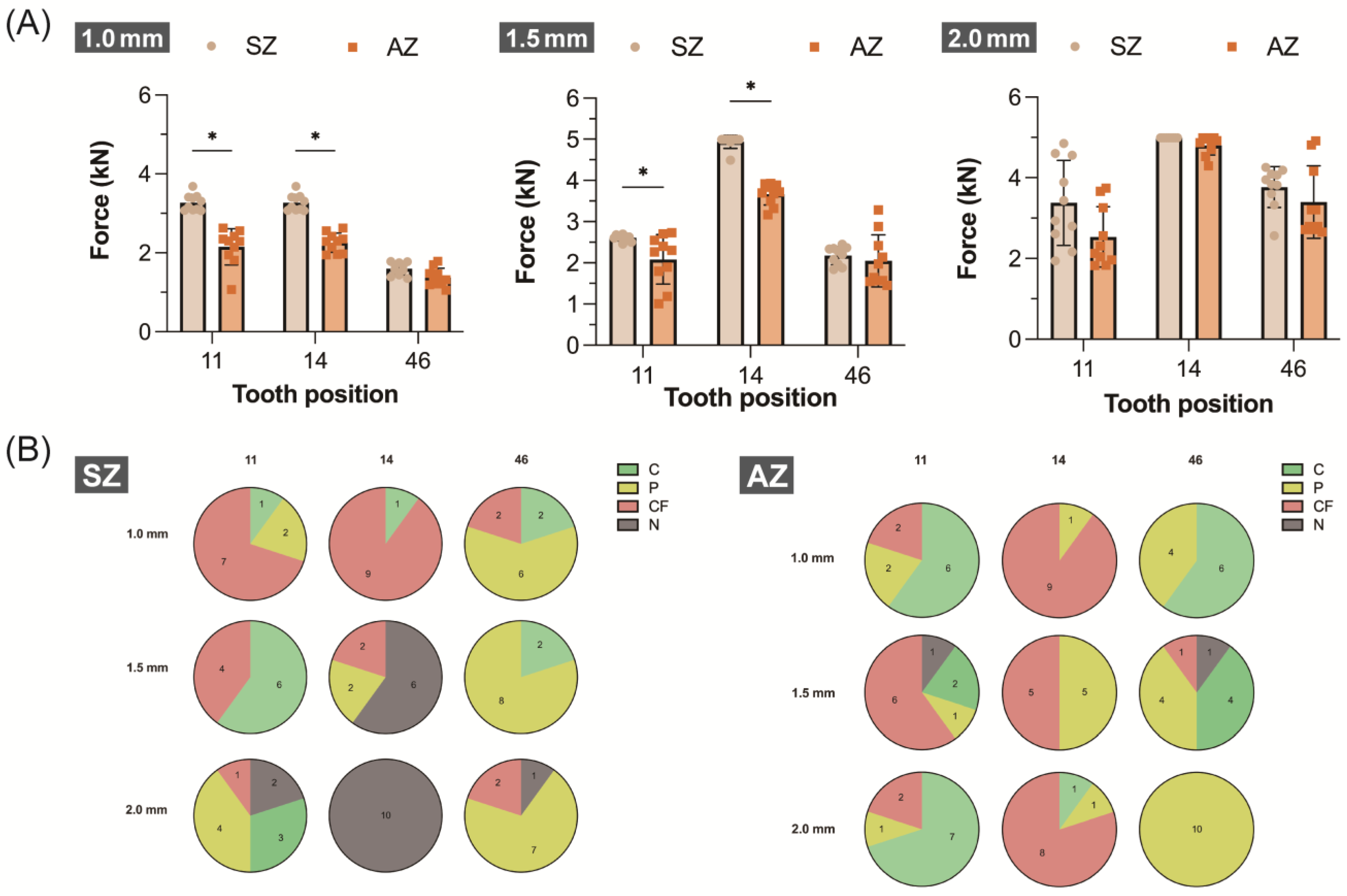
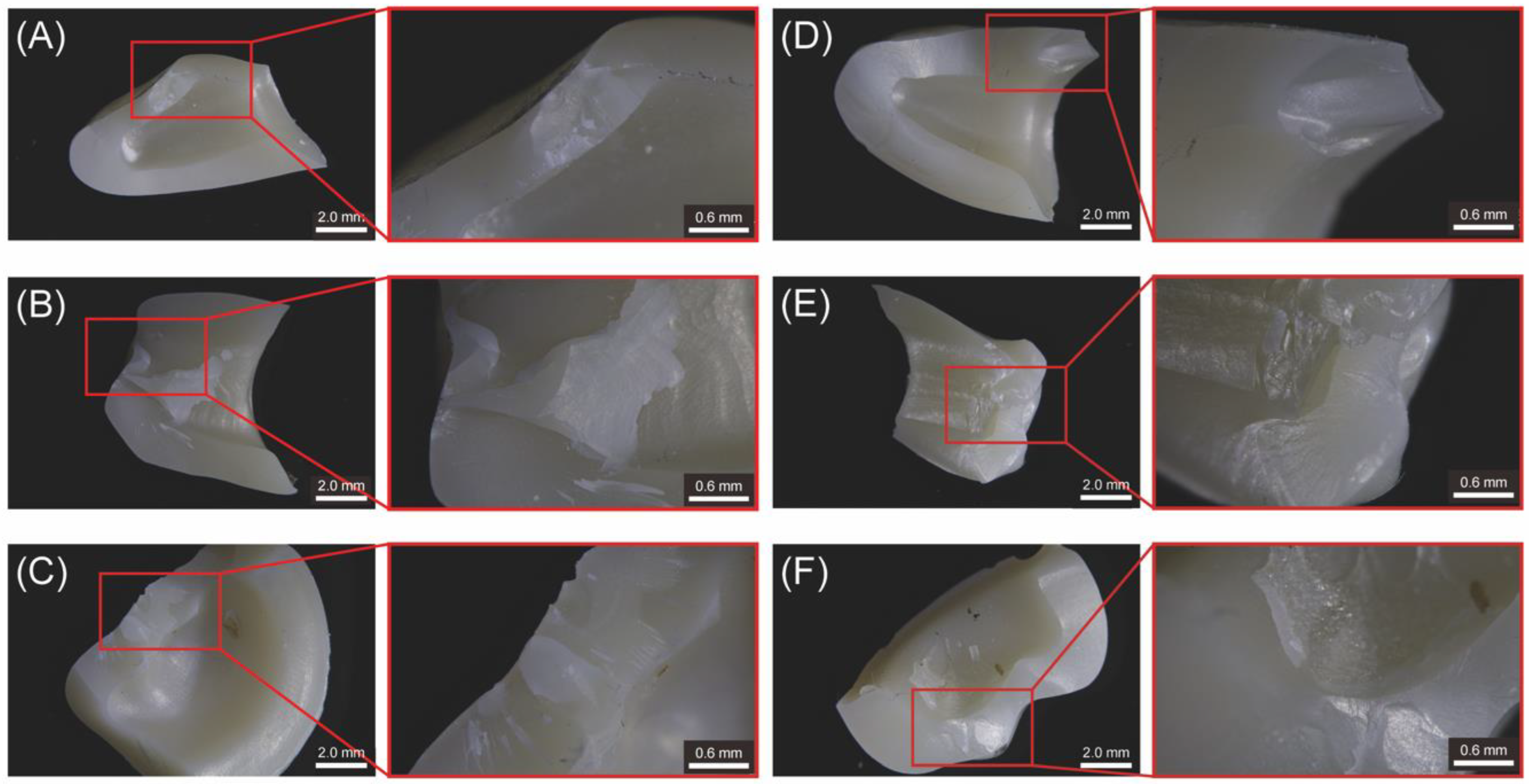
| Thickness | 0.5 mm | 1.0 mm | 1.5 mm | 2.0 mm | |||||||||
|---|---|---|---|---|---|---|---|---|---|---|---|---|---|
| Color Attributes | L* | a* | b* | L* | a* | b* | L* | a* | b* | L* | a* | b* | |
| SZ | WS | 81.0 ± 0.4 | 2.8 ± 0.5 | 16.1 ± 1.0 | 77.4 ± 0.5 | 3.6 ± 0.4 | 18.6 ± 0.2 | 76.0 ± 0.6 | 4.1 ± 0.2 | 18.0 ± 0.2 | 74.7 ± 0.5 | 4.1 ± 0.4 | 17.9 ± 0.5 |
| BS | 69.4 ± 0.1 | 0.5 ± 0.1 | 9.6 ± 0.3 | 68.8 ± 0.3 | 0.6 ± 0.3 | 11.8 ± 0.2 | 69.3 ± 0.3 | 1.5 ± 0.2 | 12.0 ± 0.2 | 69.3 ± 0.5 | 1.5 ± 0.4 | 13.0 ± 0.3 | |
| ΔEWS | 3.8 ± 0.1 | 3.6 ± 0.2 | 3.7 ± 0.1 | 4.0 ± 0.4 | |||||||||
| TP00 | 9.7 ± 0.1 | 8.2 ± 0.2 | 6.7 ± 0.3 | 5.7 ± 0.3 | |||||||||
| AZ | WS | 82.2 ± 0.2 | 1.1 ± 0.3 | 13.6 ± 0.3 | 79.2 ± 0.5 | 2.0 ± 0.1 | 16.7 ± 0.3 | 75.7 ± 0.2 | 2.1 ± 0.1 | 17.9 ± 0.5 | 74.3 ± 0.1 | 2.2 ± 0.2 | 17.6 ± 0.3 |
| BS | 67.7 ± 0.2 | −1.0 ± 0.3 | 7.0 ± 0.2 | 67.2 ± 0.1 | −0.8 ± 0.1 | 9.8 ± 0.3 | 66.6 ± 0.1 | −0.7 ± 0.1 | 11.5 ± 0.4 | 66.7 ± 0.2 | −0.5 ± 0.1 | 11.8 ± 0.4 | |
| ΔEWS | 3.9 ± 0.1 | 2.4 ± 0.2 | 2.3 ± 0.2 | 2.6 ± 0.2 | |||||||||
| TP00 | 11.9 ± 0.2 | 10.5 ± 0.3 | 8.6 ± 0.1 | 7.5 ± 0.2 | |||||||||
| Thickness | Yttria Levels | ||||||||
|---|---|---|---|---|---|---|---|---|---|
| Three-Third Division | Nine-Square Division | ||||||||
| Incisal | Body | Cervical | |||||||
| Zirconia type | SZ | AZ | SZ | AZ | SZ | AZ | SZ | AZ | |
| Pearson r value | −1.000 * | −0.997 * | −0.993 * | −0.995 * | −0.986 * | −0.992 * | −0.997 * | −0.995 * | 1.000 * |
| p value | >0.001 | 0.003 | 0.007 | 0.005 | 0.014 | 0.008 | 0.003 | 0.005 | >0.001 |
| Load at Fracture (Fracture Surface Category) | ||||
|---|---|---|---|---|
| Tooth Position | 11 | 14 | 46 | |
| SZ | 1.0 mm | 2309.03 ± 405.63 (0/1/2/7) | 3270.86 ± 206.13 (0/1/0/9) | 1600.75 ± 162.72 (0/2/6/2) |
| 1.5 mm | 2609.46 ± 77.14 (0/6/4/0) | 4935.91 ± 157.05 (6/0/2/2) | 2175.71 ± 218.64 (0/2/0/8) | |
| 2.0 mm | 3378.27 ± 1054.11 (2/3/4/1) | 4992.05 ± 0.33 (10/0/0/0) | 3768.86 ± 506.69 (1/0/2/7) | |
| AZ | 1.0 mm | 1261.75 ± 366.14 (0/6/2/2) | 2257.66 ± 245.96 (0/0/2/8) | 1377.75 ± 231.48 (0/6/4/0) |
| 1.5 mm | 2083.85 ± 602.87 (1/2/1/6) | 3664.29 ± 260.35 (0/0/5/5) | 2048.25 ± 632.40 (1/4/4/1) | |
| 2.0 mm | 2533.40 ± 746.91 (0/7/1/2) | 4802.90 ± 234.44 (0/1/1/8) | 3397.52 ± 894.09 (0/0/10/0) | |
| Thickness | Yttria Level | ||||||||||||||
|---|---|---|---|---|---|---|---|---|---|---|---|---|---|---|---|
| Maxillary Right Central Incisor | Maxillary Right First Premolar | Mandibular Right First Molar | Maxillary Right Central incisor | Maxillary Right First Premolar | Mandibular Right First Molar | ||||||||||
| SZ | AZ | SZ | AZ | SZ | AZ | 1.0 mm | 1.5 mm | 2.0 mm | 1.0 mm | 1.5 mm | 2.0 mm | 1.0 mm | 1.5 mm | 2.0 mm | |
| Pearson r value | 0.570 * | 0.674 * | 0.866 * | 0.974 * | 0.913 * | 0.793 * | −0.819 * | −0.542 * | −0.438 * | −0.920 * | −0.952 * | −0.515 * | −0.507 * | −0.141 * | −0.260 * |
| p value | 0.001 | >0.001 | >0.001 | >0.001 | >0.001 | >0.001 | >0.001 | 0.014 | 0.053 | >0.001 | >0.001 | 0.020 | 0.023 | 0.554 | 0.268 |
Disclaimer/Publisher’s Note: The statements, opinions and data contained in all publications are solely those of the individual author(s) and contributor(s) and not of MDPI and/or the editor(s). MDPI and/or the editor(s) disclaim responsibility for any injury to people or property resulting from any ideas, methods, instructions or products referred to in the content. |
© 2024 by the authors. Licensee MDPI, Basel, Switzerland. This article is an open access article distributed under the terms and conditions of the Creative Commons Attribution (CC BY) license (https://creativecommons.org/licenses/by/4.0/).
Share and Cite
Kang, C.-M.; Peng, T.-Y.; Wu, Y.-A.; Hsieh, C.-F.; Chi, M.-C.; Wu, H.-Y.; Lin, Z.-C. Comparison of Optical Properties and Fracture Loads of Multilayer Monolithic Zirconia Crowns with Different Yttria Levels. J. Funct. Biomater. 2024, 15, 228. https://doi.org/10.3390/jfb15080228
Kang C-M, Peng T-Y, Wu Y-A, Hsieh C-F, Chi M-C, Wu H-Y, Lin Z-C. Comparison of Optical Properties and Fracture Loads of Multilayer Monolithic Zirconia Crowns with Different Yttria Levels. Journal of Functional Biomaterials. 2024; 15(8):228. https://doi.org/10.3390/jfb15080228
Chicago/Turabian StyleKang, Chien-Ming, Tzu-Yu Peng, Yan-An Wu, Chi-Fei Hsieh, Miao-Ching Chi, Hsuan-Yu Wu, and Zih-Chan Lin. 2024. "Comparison of Optical Properties and Fracture Loads of Multilayer Monolithic Zirconia Crowns with Different Yttria Levels" Journal of Functional Biomaterials 15, no. 8: 228. https://doi.org/10.3390/jfb15080228







